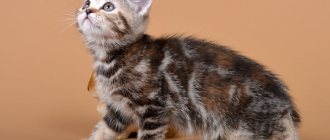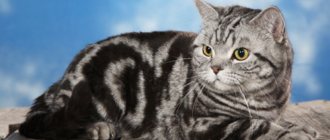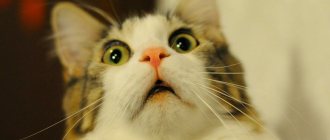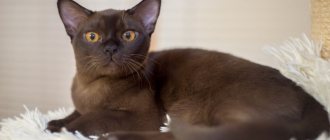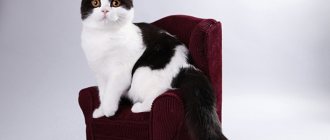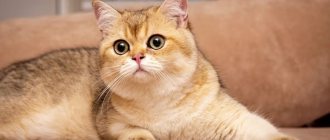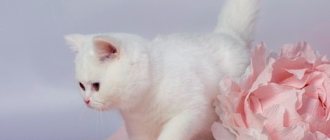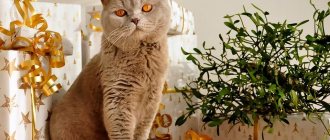Red color in the British
To breed the fiery coat color of British cats, breeders used Persian genes.
Getting a uniform color proved to be a challenge. Test work continues. Ginger British cats gained worldwide popularity at the end of the 19th century thanks to the unusual color of their fur coat, plush to the touch, and the surprised look of their large eyes. British cats have a large, muscular body, not inferior in grace to any other breed.
Description of the breed
The physiology and appearance of the British were formed under high humidity in cold climates, therefore this breed has dense short hair that protects from cold and moisture.
Since British cats are excellent hunters, they are strong, hardy and unpretentious in food.
The breed standard describes the British as follows:
- The head has a wide skull and is round. The cheeks are developed, the cheekbones are wide, the muzzle is flattened and round.
- The nose is wide, straight and short.
- The ears are rounded and small, set wide and low.
- The eyes are round, at a great distance from each other, which exceeds the width of the nose.
- The body is massive, with a developed chest and good muscles.
- The limbs are powerful, but short. Paws are rounded.
- The tail is thick.
- Weight - Males weigh 10-13 kg, and females from 6 to 9 kg.
Wool protects cats well from the cold due to the developed undercoat. It does not adhere to the body, is thick and plush to the touch.
Sometimes there are longhaired British cats. A recessive gene is responsible for long fur, so a long-haired kitten cannot appear from ordinary parents.
People often confuse British and Scottish cats: some even seriously think that there is such a breed - the British Fold. The two different breeds should not be confused.
Features of color
At exhibitions, strict requirements are put forward for pets. A Briton with a uniform, rich red color is allowed to participate. The hair is uniform throughout its length. The standard allows partial tabby coloring on the forehead in the form of the letter “M”, paws, and tail; inclusions in the form of white wool are rejected. The paw pads and nose are a brick-red, terracotta shade a tone darker than the cat's fur. Eye color is red and yellow.
British shorthair
The British Shorthair cat is characterized by a plush coat, round eyes and small ears. The coat is harsh, dense with a thick, uniformly colored undercoat. Soft is a disadvantage.
Colors of British cats
The following colors are typical for the British:
- Blue. Gray wool without light hairs. Skin is blue.
- A monochromatic color is considered if the skin, undercoat and coat itself are the same color, and there is not a single spot. Lilac is a combination of pink and blue. The nose and paws are purple. Eyes - copper or orange.
- Chocolate is a rich brown color.
- Black is a jet black color. Sometimes kittens are born with black fur, but it fades over time. This adds complexity to breeding black pets.
- White - pinkish skin and cool coat tone. Yellow spots are not acceptable.
- Cinnamon is a cinnamon color, similar to light brown.
- Fawn is a combination of creme brulee and pink.
- Marble/classic - dark spots or stripes on light sides. The eyes are copper with dark eyeliner.
- Bicolor - predominance of white at least 1/3, but not more than 1/2;
For the long-haired variety of the breed, all colors are acceptable except white and color point.
How to get color
The genetic feature of the fiery color is the impossibility of obtaining a cat of a single color. The tabby pattern is always present, although not pronounced.
Red (cream) color is usually denoted by the letter “O”, meaning red (orange). The "O" mutation is found on the female "X" chromosome. Such a gene is called sex-dependent.
The brightness of the color depends on the “D” gene: with the dominant gene (D), the pigment lies evenly, the kittens are bright red; with recessive (gene d) - vice versa: cream.
It is possible to determine whether a carrier has the gene for the required color using genetic tests.
Red color gene
Like humans, females have two X chromosomes (XX), while males have one (XY). It turns out that a fiery-colored cat is much less common.
Genetic color formula:
- OO DD/Oo DD – cat/cat of bright red color;
- OO Dd/Oo Dd – a cat/cat of a bright red color, but they are carriers of a cream color;
- OO dd/Oo dd – cream-colored cat/cat.
- The pair OO DD + Oo DD will give birth to bright red kittens.
- In the pair OO Dd + Oo Dd, no more than a quarter of the offspring will have a cream color.
- The pair OO dd + Oo dd will give birth to kittens with only cream coat color.
The probability that ginger cats with Oo dd and Oo dd formulas will give birth to kittens with a color different from their parents is 25%.
kittens
Little British Reds come in both short-haired and long-haired varieties. The richer the color of a kitten’s coat, the higher its value. Sometimes white hairs are observed on the body. If they do not disappear with age, then there should be no talk of any exhibitions. Usually kittens are born with tabby markings, but with age the pattern becomes almost invisible, and it is called monochromatic.
To maintain bright color and shine, cats' fur is washed twice a month. To avoid damage to the skin and undercoat of a ginger cat, combing with tools with hard metal teeth is not recommended. Soft, silky wool is a minus. According to standards, babies should have a thick, moderately hard undercoat.
The color of the nose is red. Particular importance is paid to eye color. An iris of orange, copper, and gold colors is welcome. Green is not allowed for exhibitions.
Cream color of British kittens
There was a time when cream coloring in cats was considered a defect. Being too light, this color could not claim to be the standard of beauty among man's furry, mustachioed friends. But times change, and so does fashion. And now cream is not only no longer considered a flaw, this color has become popular, breeders have taken care to create such a shade in cats. Thus, the Persian breed of cats with a cream color was bred in the 20s of the last century.
The ideal cream color is associated with baked milk. It is this shade that one should strive for when breeding it from cats, although minor deviations are still allowed. In addition, the ideal color should be uniform in each hair from root to tip. Breeders also need to take this important parameter into account.
It is noteworthy that in the USA they prefer a less thick and saturated cream color tone than in the UK (here they will choose the golden mean). At the same time, experts and cat lovers around the world agree that a too dark tone is undesirable.
Who would suit a red-haired Briton?
Many people think that color does not affect character. Breeders have a different opinion: British redheads are considered to be real aristocrats. They do not bother their owner by meowing. They don’t get in their way when begging for anything. They are reserved and independent. They lead a sedentary, quiet lifestyle.
Smart by nature. They become toilet trained instantly, all you have to do is show the kitten the litter box once. British cats are clean and do not require careful, long-term care. Cats have good health.
British ginger cats are attached to their owners, but are not known for their affection: they rarely allow themselves to be stroked and do not sit on laps. They get along with both children and animals: a dog will become a good friend for a Briton. They play with children according to their mood, often ignoring them. When a person pays increased attention to his person, he will not release his claws and will prefer to leave. They love solitude, and therefore are suitable for busy and business people.
Solid colors in British cats
Solid colors in this case come in the following types:
- The most popular and well-known color among British cats is blue. More precisely, this is actually the name of the gray color. The hair must be dyed evenly throughout its entire length. The cover is generally soft and dense. The standard allows for protruding hairs, but they should not protrude much. A blue cat's fur should not be shiny. As for shades, light gray is preferable. Dark is possible, but breeders are less happy with it. Eye color should be bright golden, orange, copper.
- The black shorthair British cat is beautiful, but the requirements for this color are strict. So, the undercoat must necessarily blend in tone with the main coat. Even the paw pads and nose must be black. In this case, shine is allowed. The eyes are the same as in the previous case.
- White color suggests purity and uniformity. No yellowness, haze effect, spots or stripes! The pads and nose of this short-haired cat have a delicate pinkish tint. As for the eyes, they can have such a rare type of color as heterochromia. However, there are also completely orange and blue ones. Despite the beauty of such British pets, it is not recommended to cross them with each other, since there is a high probability of obtaining deaf individuals as a result.
- The chocolate-colored British shorthair cat always looks elegant due to the successful combination of brightness and color saturation. This color is often called “brown”. The iris has a rich copper tone. The paw pads and nose are chocolate. However, you should not immediately worry about any discrepancy: this type of color goes through a long stage of formation - on average, up to 1-1.5 years.
- The lilac British cat can be light, dark or medium in the saturation of the fur pigment. Professional breeders most often prefer the first option. Sometimes it happens that a lilac shorthaired baby has a fuzzy pattern. There is no need to worry, as by 6 months it will disappear, giving way to monotony.
- The cream version is often also called “peach” or “beige”. It itself is quite gentle and does not require additional lightening inclusions like white hairs. The pads on the paws, as well as the nose, should also not be pigmented.
- The red version allows for greater loyalty than in the previous case. Ideally, there should be no markings, but a uniformly colored, as it is called, “red” British cat is rare. Therefore, breeders allow concessions in the form of a weakly expressed pattern on the paws and head. But in any case, a short-haired animal must have a rich coat.
RED (RED) BRITISH: PHOTOS OF ADULT CATS AND CATS
The British red cats in the photo are bright representatives of the beautiful red color.
Genetics of the red (red) color of the British
The British Shorthair breed allows for approximately 250 different color combinations, with solid colors playing a major role. Ginger cats are not unique here, they are often found in litters and were once even quantitatively ahead of the blue-gray color that is considered traditional for the British.
All the tools of the genotype take part in the process of color formation: chromosomes and genes, alleles, loci and pigmentation.
- The main role in the formation of the red color in the British is played by the pigment pheomelanin - elongated ellipsoidal granules that reflect light in the range of red, yellow and orange shades.
- Genes are a library of hereditary data that is passed on from parents to offspring and continues the chain of ancestral connections ad infinitum.
- Alleles come in different forms that genes can take on. They are located on certain parts of the chromosomes - in the example of red British cats, this is a very important point.
- Locus is the location of a gene (allele) in an ordered list of chromosomal compounds.
There are 19 pairs of chromosomes in a cat's set. They store the hereditary instructions, and any deviation from the norm ends in an uncontrolled mutation. British redheads are not subject to this risk, as they are an ancient breed with an established genotype.
Genes and chromosomes that influence the formation of red color are distributed as follows:
- The O (orange) gene is responsible for the production of the red pigment pheomelanin in the British (and not only in them). It has only one permanent locus attached to the X chromosome, which determines the sex of the future kitten.
- The O gene exists in 3 alleles: OO (natural red), Oo (red and black tortoiseshell British), oo (red is blocked and does not cause pheomelanin pigmentation). The final example in practice means only one thing - the cat will be black.
- For ginger cats, there are 3 color combination options: OO, oo and Oo. For red British cats, only 2 options are possible - O and O, since they have one X chromosome.
- According to the laws of genetics, a British cat inherits the orange gene from its mother. Therefore, in a pair with a red mother and a blue-gray father, male kittens will definitely receive the properties of the red gene, and the female cats will be tortoiseshell, cream or blue.
This is interesting! There are many more ginger British cats than cats, because boys receive the color gene only from their mother, and girls inherit the properties of both parents.
All British red coats have a tabby pattern on their coats. It is formed under the influence of the A gene (agouti) and exists in two alleles: dominant A and paired homozygous aa. In the second case, agouti suppresses another important component of the genotype - the T (tabby) gene, which is responsible for the ornamentation on the fur coat.
The unique property of the red color is that aa (not agouti) has no effect on it. Therefore, all red British cats are always tabby.
The L gene is also involved in the formation of red color. Thanks to him, purebred British cats have short and thick hair.
Important! The birth of a red or cream female kitten suggests the presence of a dominant O gene in the genotype of two British parents. Only direct pedigree lines influence the external characteristics of the offspring.
About British cats
In the world of purebred cats, the British occupy a leading position in popularity, while remaining mysterious and incomprehensible. Like the Cheshire Cat in Lewis Carroll's famous book, this amazing character is of obvious British origin.
The Cheshire Cat is a clear representative of the British breed
History of the breed
The official date of birth of the British breed is considered to be July 13, 1871, and the place of birth is the Crystal Palace in London. On this day, the first British exhibition took place here, which created a real sensation and became the start of the victorious march of the new breed around the world.
However, to call the British breed new at that time would be completely wrong - the formation of the British began long before the end of the nineteenth century, when these feline aristocrats received their official recognition. According to one version, the historical roots of the majestic breed should be sought not just anywhere, but in Ancient Rome.
The British breed began with a blue color
In ancient English engravings and paintings, cats are often found that are practically indistinguishable from modern British cats. They enjoyed truly popular love: they lived at the royal court and in the castles of the nobility, but at the same time they also lived in the farmsteads of commoners. British sailors and fishermen respected these cats for their strong and loyal character, endurance and courage - already several centuries ago, the ancestors of our beloved Britons honestly served as cats on merchant and fishing ships, warships...
Since those ancient times, they have managed to preserve both their appearance and charisma, as well as truly royal habits - everything for which we love this wonderful breed so much.
The British are the royal dynasty of the cat world
Purely British characteristics
The British are quite large cats, stocky, with a strong texture, and it is no coincidence that the owners love to call their pets teddy bears. By the way, only short-haired British dogs are “plush”, however, long-haired representatives of this breed are still less popular.
A massive strong body, strong low paws, a thick tail, a round head, huge, fantastically expressive eyes - this is how the breed standard paints a vivid image of this cat, worthy in all respects.
This look will not leave anyone indifferent
When it comes to character, the British are by no means teddy bears. They are distinguished by a very high sense of self-esteem, self-sufficiency, intelligence, calmness and patience - the best traits of a true English lord. No plebeianism, like jumping on your head or tearing wallpaper to shreds! The Briton is interested in human society, but he will never allow excessive familiarity towards himself.
Video: everything about the British breed
British red color standard
There is a uniform standard of coat quality and color for all British Shorthairs. Felinologists are trying to preserve this indigenous breed unchanged. Therefore, experts carefully monitor all experiments aimed at diversifying the colors of cats.
- The coat is short, elastic, silky. In red color, stiffer guard hair is allowed, which should not fit tightly to the body.
- Bright red British cats have an undercoat of the same shade as the main coat. Bald spots of a different color and uneven coloring are not allowed.
- The chin, tip of the tail and a small area on the belly may be slightly lighter than the base coat shade. In pedigree breeding, such a transformation is not welcomed, but at exhibitions experts are loyal to it.
Additional requirements apply to eye color, paw pads and nose:
- The pupil is always colored in honey, orange or copper tones.
- The color of the skin of the nose and pads is darker than the base color - brick, terracotta or bleached brown.
In red British cats, the tabby pattern will always be contrasting. There should be clear lines on the chest and neck. The same pattern starts from the corners of the eyes and covers the cheeks. On the paws and tail there are distinguishable encircling rings of the primary color.
Acceptable variations and deviations in British Reds
All colors containing red in the British are divided into several categories.
British breed colors
In addition to all its numerous and undeniable advantages, the British cat breed is famous for its bright and generous palette of colors - almost their entire line is presented in the breed standard. Only the most popular and well-known colors among the British have up to six dozen! And if you count new, rare colors and variations, the total number will be up to two hundred.
Different colors may be present in one litter
But even this seemingly democratic approach to the variegated ribbon of colors is clearly regulated by the breed standard in each specific case. In the exhibition evaluation of an animal, there is a very large quota of expert evaluation specifically for color - according to the standards of various international felinological organizations, this ranges from 15 to 25 points.
British cats of all stripes - photo gallery
Blue (gray)
The blue color can be called classic for the British cat breed. Against the background of plush gray fur, huge eyes of all shades of amber look especially impressive.
Cinnamon - red tortoiseshell color in the British
Tortoiseshell coloring is common in British cats. It is formed by a harmonious combination of evenly colored red and black hairs. But in the case of ginger cats, cinnamon (cinnamon) replaces black and goes with any shade of red.
There are no strict rules regarding the size and number of spots in the British tortoiseshell cat color variety. It is genetically impossible to predict how they will lie on the wool, and therefore any arrangement is allowed.
In tri-colored British tortoiseshell cats, white is added to the two standard spot colors (red-black or cinnamon). Such animals are sometimes called patchwork animals, although this definition does not accurately describe their appearance.
Usually female kittens are born with a tortoiseshell color. However, nature sometimes experiments unsuccessfully, and cats become the owners of an additional chromosome (XXY). In this case, they are also born “turtles” and, most likely, will be infertile.
Story
The first mentions of this breed are found in ancient chronicles. There is no documented information about their origin. The first very large rat-catching cats were brought in by Roman centurions. Researchers suggest that cats were introduced by the Romans during an attack on the British Isles in 43 AD. e. In Britain they were called the “British cat”, in France - “Charteuse”, in Germany - “Carthusian cat”.
The animals were used as rodent hunters, but by the end of the 16th century, breeders paid attention to the appearance of cats. The British attended the first London cat show in 1871. Then official breed standards were adopted, and felinology began its rapid development.
The first British appeared in Russia in 1992, along with the Cartheusers, who are now called in Russia “the old type of British.”
To consolidate the unique features of the British, breeders used Persian cats - which is why British cats have a slightly flat face.
Rules for caring for a British pet's coat
The rules for caring for the coat of red British cats do not differ from cats of this breed with other colors.
- The animal is combed 1-2 times a week to remove excess hair. Both standard combs and special mittens are suitable for this. A thick undercoat will require regular grooming. You should not let it fall into a tight felt boot, which prevents the skin from breathing freely.
- During active molting, treatment is repeated daily, and sometimes several times a day.
- Almost all cats do not like water, so thorough combing and treating the coat with a damp cloth is the best hygiene procedure for a red British cat.
Coat quality is an objective indicator of a cat's health. As soon as it loses its shine, begins to roll into untidy icicles or falls out intensively, it means your pet has health problems.
This is interesting! To maintain a high-quality red color, felinologists recommend introducing seafood into the cat’s menu. They contain a lot of iodine, which makes the color rich.
Pros and cons of British redheads
All British cats, regardless of coat color, are distinguished by their independence and even a certain amount of unhealthy selfishness. At home, they prefer privacy and communicate with the owners only when they themselves want to. The expression “a cat walks on its own” applies to the British breed in the best possible way.
It has been noticed that ginger cats are more loyal to family members than their blue-gray or black “relatives”.
Interestingly, homebodies and introverted people rarely choose Britons as pets. This cat is ideal for those who work a lot and are often away from home.
The animal easily tolerates loneliness, so after enjoying the solitude to the fullest, in the evening the Briton kindly greets the owner and even sits on his lap with pleasure. And this is enough to make your vacation cozy and comfortable - a good home, a strong family and a ginger cat that greets the owner with a quiet purr.
Source
Chinchilla
This species is considered the most expensive, as it is difficult to breed. At the same time, chinchillas are in great demand, which is determined by the depth of tone of the coat. As for shades, you can find the following individuals:
- Golden ones can boast of a rich apricot undercoat. But duller gray, silver is always defined as defective. The eyes must certainly be green, other variations are not allowed. At the same time, they certainly have eyeliner that matches the main palette of the animal.
- The silver chinchilla is more common than the previous one. However, even in this case there are strict requirements: for example, the undercoat must be white and the eyes must be green. The silver shade is especially rich on the sides, back and tail. If the breeder is inexperienced, he may breed individuals with spots. It is highly not recommended to allow such yellowish spots, since the cat will almost certainly be rejected in the future. This so-called “poor silver” is most often the result of an admixture of individuals with gold.
Nature was pleased to color British shorthair cats in more than 200 shades! These data are impressive and, of course, it is impossible to describe all possible variations in one article. However, it is definitely worth knowing about the most famous ones for beginning breeders.

